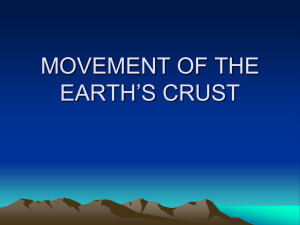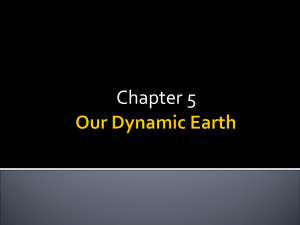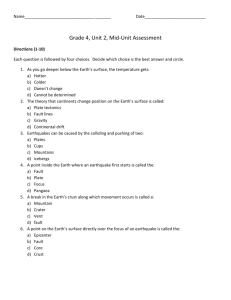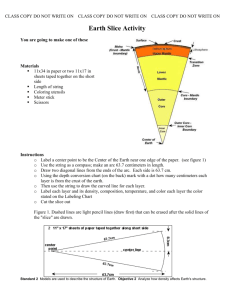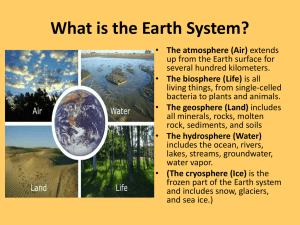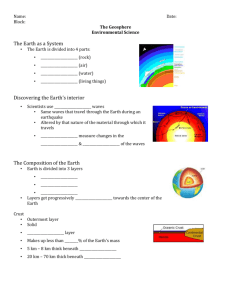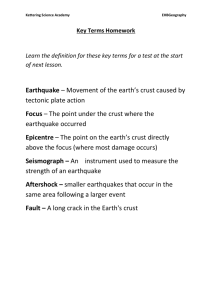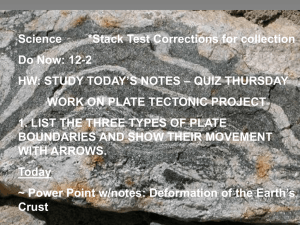Quiz 13 on Chapters 13-15 Notes to Landforms, Internal Processes
advertisement
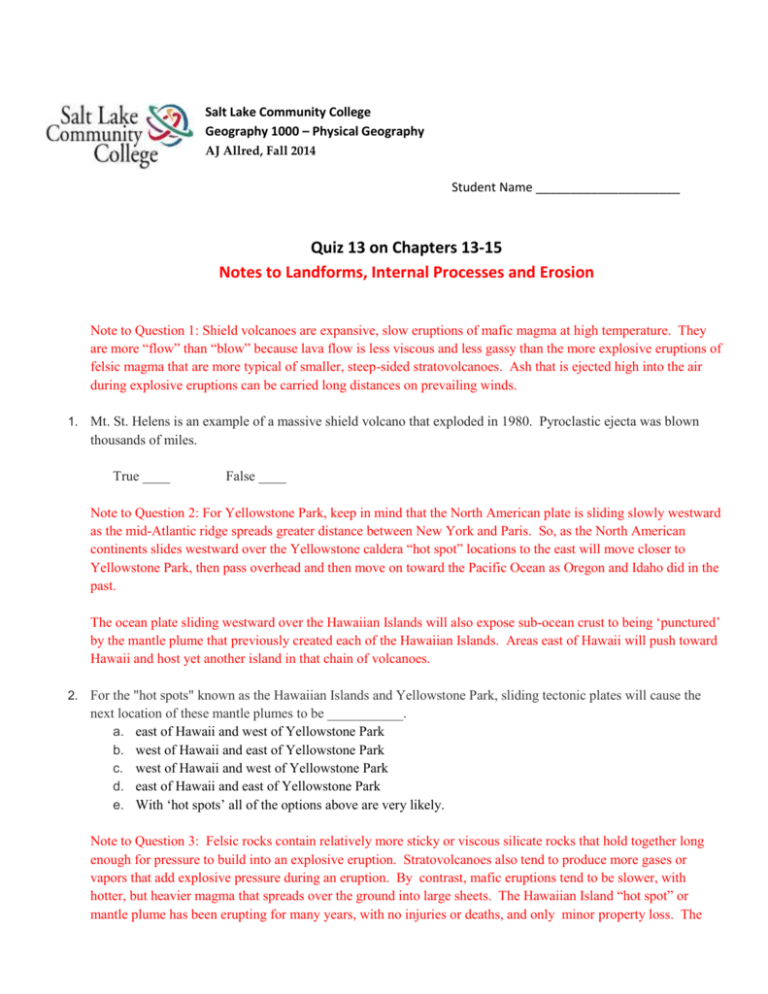
Salt Lake Community College Geography 1000 – Physical Geography AJ Allred, Fall 2014 Student Name _____________________ Quiz 13 on Chapters 13-15 Notes to Landforms, Internal Processes and Erosion Note to Question 1: Shield volcanoes are expansive, slow eruptions of mafic magma at high temperature. They are more “flow” than “blow” because lava flow is less viscous and less gassy than the more explosive eruptions of felsic magma that are more typical of smaller, steep-sided stratovolcanoes. Ash that is ejected high into the air during explosive eruptions can be carried long distances on prevailing winds. 1. Mt. St. Helens is an example of a massive shield volcano that exploded in 1980. Pyroclastic ejecta was blown thousands of miles. True ____ False ____ Note to Question 2: For Yellowstone Park, keep in mind that the North American plate is sliding slowly westward as the mid-Atlantic ridge spreads greater distance between New York and Paris. So, as the North American continents slides westward over the Yellowstone caldera “hot spot” locations to the east will move closer to Yellowstone Park, then pass overhead and then move on toward the Pacific Ocean as Oregon and Idaho did in the past. The ocean plate sliding westward over the Hawaiian Islands will also expose sub-ocean crust to being ‘punctured’ by the mantle plume that previously created each of the Hawaiian Islands. Areas east of Hawaii will push toward Hawaii and host yet another island in that chain of volcanoes. 2. For the "hot spots" known as the Hawaiian Islands and Yellowstone Park, sliding tectonic plates will cause the next location of these mantle plumes to be ___________. a. east of Hawaii and west of Yellowstone Park b. west of Hawaii and east of Yellowstone Park c. west of Hawaii and west of Yellowstone Park d. east of Hawaii and east of Yellowstone Park e. With ‘hot spots’ all of the options above are very likely. Note to Question 3: Felsic rocks contain relatively more sticky or viscous silicate rocks that hold together long enough for pressure to build into an explosive eruption. Stratovolcanoes also tend to produce more gases or vapors that add explosive pressure during an eruption. By contrast, mafic eruptions tend to be slower, with hotter, but heavier magma that spreads over the ground into large sheets. The Hawaiian Island “hot spot” or mantle plume has been erupting for many years, with no injuries or deaths, and only minor property loss. The shield volcano associated with the Hawaiian “hot spot” is broad and shallow, as compared to steep-sided, explosive stratovolcanoes, and yet has accumulated enough magma to become the tallest mountain on Earth. Volcanoes are not known for ejecting nitrogen, but acidic conditions can result from volcanic eruptions when sulfur and carbon dioxide are involved. 3. A stratovolcano eruption typically features ________. a. b. c. d. e. mafic rocks, including basalt and/or granite igneous "fire rocks" that are high in iron and low in silicates felsic rocks that are relatively high in silicates oxides of nitrogen that promote plant growth and acid rain downwind All of the above are associated with explosive eruptions Note to Question 4: The mid-Atlantic ridge is a rift or divergence zone where new crustal material is being formed, causing adjacent continents to be pushed away from each other. Subduction is an opposite process wherein two plates collide, with the heavier side sliding underneath the other (subduction). 4. The mid-Atlantic ridge is an under-ocean collision zone between major tectonic plates. The result is subduction of relatively heavy rocks beneath lighter rocks. True ____ False ____ Note to Question 5: Volcanic eruptions can indeed bring new magmatic, igneous material to the surface where they cool into small, hard crystals. However, granitic rocks are large crystals that cooled-off below the surface and under great pressure. Known as “plutonic” intrusions, granite is exposed on the surface only when earthquakes and erosion remove covering rocks to expose the granite underneath. By comparison to intrusive, or plutonic igneous crystals, lava that flows on the surface cools quickly into small crystals. 5. Granite is a popular building material in Utah because of extrusive volcanic eruptions that brought these useful rocks to the surface. Large-crystals in these extrusive rocks look somewhat like shaved ice sprinkled with salt and pepper in red, white or black tones. True ____ False ____ Note to Question 6: Wasatch Front mountains are formed by block-fault earthquakes, with one side rising and the other sinking. As described in the note to Question 5 above, the granite rocks in mountains east of Salt Lake City are from magma plutons that never reached the surface on their own, but cooled gradually underground to form rocks that are very different from lava on the surface. In Central Utah, some mountains are indeed volcanic in origin, but they are tall, steep-sided stratovolcanoes rather than shallow-sloped shield volcanoes. The only true statement in Question 6 is that there are small cinder cones to the west of I-15 in central Utah and elsewhere. 6. The Wasatch Front mountains are remnants of volcanoes that became dormant in relatively recent geologic time. Further south, small cinder cones are prominent in west-central Utah and can be seen from I-15. Genuine 12,000 foot tall shield volcanoes are also visible along the east side of the freeway near Beaver, Utah True ____ False ____ Note to Question 7: The famous San Andreas fault is a transform, or slip-strike fault that is indeed about 1,000 miles long. Also true is that ocean side of that fault zone is moving northward and will eventually slide into the ocean somewhere north of San Francisco on its way toward Alaska. Slip-strike fault zones are side-by-side, horizontal movements rather than vertical movements, so the San Andreas fault zone does not produce high mountains such as are found near Salt Lake City. There is no subduction with ordinary block faults, or with ordinary transform faults. 7. The dangerous San Andreas fault in California is a very long block fault where coastal Los Angeles is slowly subducting under the eastern side (Arizona side). In the 1970s, popular mythology predicted that coastal California would fall into the ocean. True ____ False ____ Note to Question 8: The Himalayan mountains are formed by ‘convergence uplift’ wherein two light-weight crustal plates collide. Neither one subducts under the other, so very high mountains are possible. The Pacific “Ring of Fire” does influence some events over in the Indian Ocean basin, but plays no role with Himalaya formation. The Himalayan mountains would be much taller were it not for rapid erosion that is ongoing even as these mountains continue to thrust upward. 8. The world’s tallest mountains are being shaped by __________________. a. b. c. d. e. subduction and deformation that is typical of the "Ring of Fire" massive transform block faults that produce strong vertical thrusts "Ring of Fire" volcanoes and earthquakes that spill over into the Indian Ocean a combination of tectonic convergence and erosion A Combination of all of the factors above is required for such massive mountains. Note to Question 9: Subduction occurs when heavier crust slides under lighter crust. Typically, crust under oceans is slightly heavier than crust that forms lightweight continents that are above sea level. So, heavier subocean crust slides under lightweight continental crust at collision zones. Felsic rocks, popcorn lava, granite and similar volcanic features are too insignificant to influence the massive subduction process. 9. Tectonic subduction zones are the result of __________________. a. heavier granite rocks sliding below rocks that contain small amounts of silica, aluminum and oxygen b. relatively light-weight felsic rocks and pyrocolastics such as "popcorn lava" sliding over heavier granitic rocks c. Both of the above are true. d. None of the answers above is true. e. flood basalt that slides under mafic rocks. Note to Question 10: A volcanic dike is an intrusion of lava that reaches toward the surface. After cooling and becoming hard, these thin, narrow volcanic “fingers” may be gradually exposed on the surface as erosion removes cover material. All of the other items listed in Question 10 are associated with earthquake-induced fractures on the surface. In some cases, a rift valley could be caused by new magma, but generally a rift valley is where landforms collapse downward when the sides are pulled away from each other. A graben would be similar in effect to a rift valley. 10. Which of the following does not belong with the others? a. b. c. d. e. Graben Horst Rift valley Overthrust Dike Note to Question 11 The Hawaiian Island “hot spot” is a mantle plume or “puncture” in the Earth’s crust, rather than a long fracture zone. The Hawaiian Islands are nowhere near any of the Pacific “Ring of Fire” that involves extensive subduction collisions around the rim of the Pacific Basin: Everything else in Question 11 is true. 11. Which of the following is not true? a. b. c. d. e. The “big” island of Hawaiian island is a larger tectonic feature than Mt. Everest. One of the hazardous stratovolcanoes in Hawaii is currently erupting. Shield volcanoes are less associated with viscous silicates and gases than are stratovolcanoes. Reversal of Earth's magnetic poles does not automatically cause a period of intense volcanic activity. The Hawaiian Islands are a geologic 'hot spot' along the Pacific "Ring of Fire" subduction zone. Note to Question 12: Everything in Question 12 is true. 12. Migration of the North American plate away from Europe helps explain why the Yellowstone "hot spot" is now in Wyoming instead of Idaho or Oregon where it was in the past. True ___ False ____ Note to Question 13: The strong vertical face of the Sierra Nevada mountains on their eastern side is nothing like a side-by-side, or horizontal transform fault. By definition, a scarp is a steep or nearly vertical face of rock that has either been uplifted or is a remnant of erosion that removed everything else nearby. A syncline is a dip in Earth’s crust caused by compression from either side that squeezes crust enough to cause folding or buckling. 13. The east face of the Sierra Nevada mountains is an example of a ____________. a. b. c. d. e. Fault scarp Syncline Graben and horst formation Transform fault None of the above. Note to Question 14: Everything that happens on Earth is a function of either heat from radioactive decay deep within the Earth, or radioactive fusion on the Sun that sends electromagnetic energy to Earth. So, the creation of mountains is the result of molten rocks that are heated by radioactive heat. Erosion and weathering of mountains are the result of solar energy that has been absorbed by water to cause a variety of chemical and mechanical destruction of landforms. 14. Radiation is the source of energy for creating mountains and eroding them into dust. True ____ False ____ Note to Question 15: See the note to Question 10 for volcanic dikes. Sills, laccoliths and batholiths are also volcanic intrusions that typically do not reach the surface until overlying rocks is gradually eroded away to expose them. Flood basalt is extrusive volcanic activity in which lava reaches the surface and spreads out slowly over large areas, cooling quickly into small, easily crystals. 15. Which of the following features is formed on top of Earth’s crust? a. b. c. d. e. Dike Laccolith Sill Batholith Flood basalt Note to Question 16 Continental crust is typically lightweight, stable material that sort of “floats” easily over mantle below. Volcanoes are not common in the middle of such crust. Instead, magma is moving toward the surface convectively (hot material rises) along mid-ocean ridges, as new crustal material is formed and pushes outward, spreading continents away from each other. Subduction zones often have volcanoes, but only as an incidental “leakage” of crustal material that is re-melting. 16. Where under the surface of the Earth would one expect a convection current directed towards the surface? a. Under continents b. Under subduction zones c. In the core d. Under mid-ocean ridges e. In the center of active plates Note to Question 17: A transform fault zone does not subduct and re-melt crust. Instead, plates slide horizontally past each other. Divergent boundaries tend to produce new crust, and subduction zones “consume” crust as the heavier plate slides under the lighter plate and re-melts. A fault scarp is just a simple vertical fracture near the surface of the crust. 17. A ____________ plate boundary is associated with lateral slippage, conservation of existing crust, and the San Andreas fault system. a. Convergent b. Fault scarp c. Divergent d. Subducting e. transform Note to Question 18: An “accrete teranne” means “accretion or addition of terrain. When two continental plates collide they add to each other. The west coast of the United States is composes of a variety of islands (lightweight crust) that collided over time. Subduction zones tend to destroy crust, rather than increase it by accretion or collision. Transform plates neither create or destroy dry crust. A long series of hot spot volcanoes creates small amounts of new crust that don’t add to anything else. 18. Portions of the North American west coast and the Indian sub-continent both represent _______. a. Accrete terrane b. c. d. e. Subduction zones Transform plates or faults Terracette A long series of ‘hot spot stratovolcanoes Note to Question 19: A rift valley is sinking because the edges are being pulled away from each other, allowing the valley to sink. All of the other features in Question 19 involve compression, as crustal material is squeezed together, sometimes enough to cause it to buckle, fold, warp, or thrust over other crust. Compression squeezes things together; rifting pulls them apart. 19. Which of the following is not a form of folding? a. b. c. d. e. Anticline Monocline Overturned fold Syncline Rift valley Note to Question 20: Islands that grow by accretion or collision are not the largest of crustal plates, they just add bit-by-bit to other plates. The west coast of North America is larger by addition of many accretions over time, but none of them is larger than the continent itself. 20. Which of the following is not true of ‘accrete terranes’ in North America? a. b. c. d. e. Some of them originated south of the Equator Dozens of them exist They have gradually increased the size of North America. They are the largest of all types of crustal plates. They tend to contain rocks that are too buoyant to subduct.

